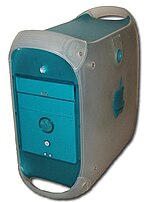Power Macintosh G3 (Blue & White)

The Blue & White Power Macintosh G3.
|
|
| Developer | Apple Computer Inc. |
|---|---|
| Type | Desktop (Minitower) |
| Release date | January 5, 1999 |
| Introductory price | $1,599 |
| Discontinued | August 31, 1999 |
| CPU |
PowerPC G3, 300 – 450 MHz |
| Predecessor | Power Macintosh G3 Beige |
| Successor | Power Mac G4 Graphite |
The Power Macintosh G3 series (commonly known as the "Blue and White G3", or sometimes either as the "B&W G3", "Yosemite G3" or "Smurf Tower" to distinguish it from the original Power Macintosh G3) is a short-lived series of personal computers designed, manufactured and sold by Apple Computer Inc. as part of their Power Macintosh line. It was introduced in January 1999, succeeding the original "beige" Power Macintosh G3, with which it shared the name and processor architecture but little else; it was discontinued in favor of the Power Mac G4 line in August 1999.
The Blue & White G3 used a modified version of the memory/PCI controller, the Motorola MPC106 (codenamed "Grackle"); it used the MPC106 v4. The I/O "Heathrow" had been replaced by "Paddington" (adding 100 Mbit Ethernet and power save features), the audio chip "Screamer" (on the beige G3's "Personality Card") had been replaced by "Burgundy", and other controllers for Firewire (Texas Instruments PCI-Lynx), for USB etc. were added.
Though still based on the PowerPC G3 architecture, the G3 B&W was a totally new design. The first new Power Mac model after the release of the iMac, it used a novel enclosure with the logic board on the folding "door", which swung down onto the desk for easy access (a design that was also used on all Power Mac G4 models except for the Cube), and borrowed the iMac's blue-and-white color scheme. It also introduced the New World ROM to the Power Macintosh line.
The faster models (not the 300 MHz model) used the new copper-based PowerPC G3 CPUs made by IBM, which used about 25% of the power of the Motorola versions clock for clock. The B&W line ranged from 300 to 450 MHz. Despite its 100 MHz system bus and PC100 SDRAM, the 300 MHz B&W G3 performed worse than its 300 MHz Beige predecessor, because it had only 512 KB L2 cache, half of what the 300 MHz Beige had. The logic board had four PCI slots: three 64-bit 33 MHz slots, and one 32-bit 66 MHz slot dedicated for the graphics card, an ATI Rage 128 with 16 MB SGRAM. Four 100 MHz RAM slots accepted PC100 SDRAM modules, allowing the installation of up to 1 GB of RAM with the use of 256 MB DIMMs. The onboard ATA was upgraded to Ultra ATA/33 (in fact an extra UDMA-33 controller was added, see above), but SCSI was no longer present, having been replaced by two FireWire ports, a new standard (IEEE1394) running at 400 Mbit/s (50 MB/s) — faster in theory than even the ATA/33 (33 MB/s) hard drive controller. The serial ports were gone, too, having given way to two USB 1.1 ports (12 Mbit/s), as implemented already in the iMac. The ADB port remained, as did the option for an internal modem. Also gone was the internal floppy disk drive. 100BASE-TX Ethernet was now standard, and audio was moved back to the logic board. A Zip Drive remained an option, and some configurations included a DVD-ROM drive and a DVD-Video decoder daughtercard for the graphics card, allowing hardware-assisted DVD video playback.
...
Wikipedia
